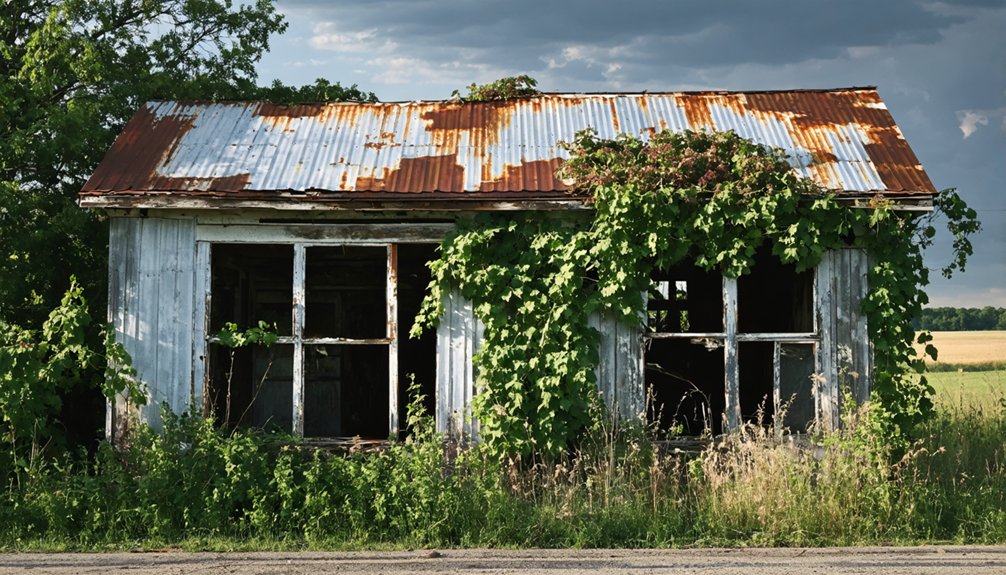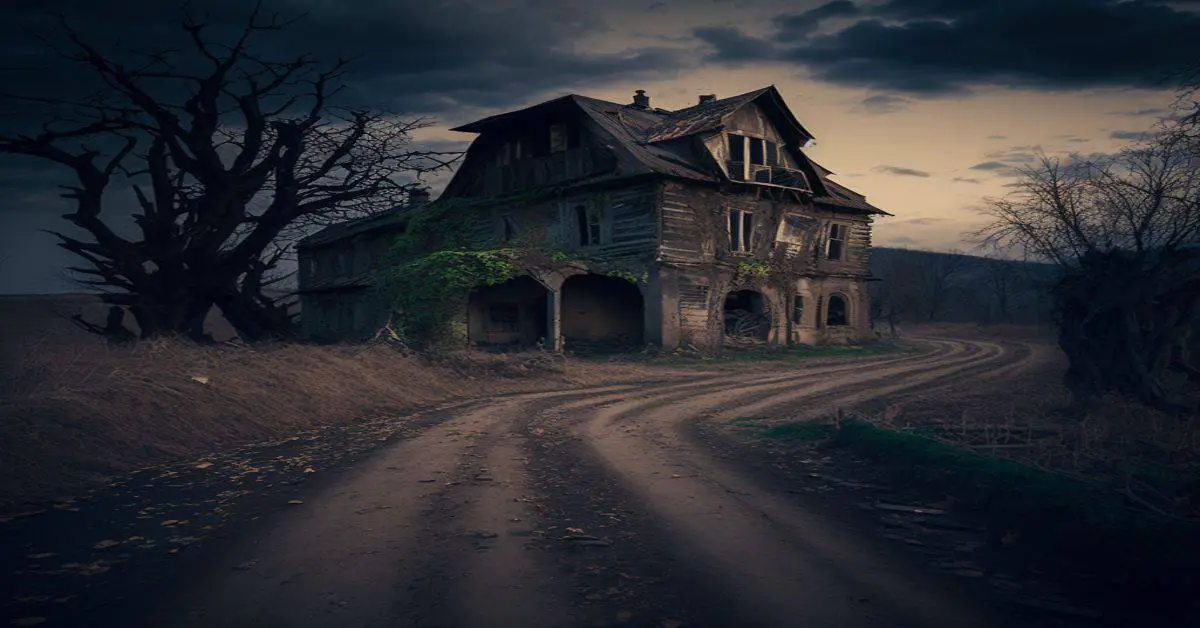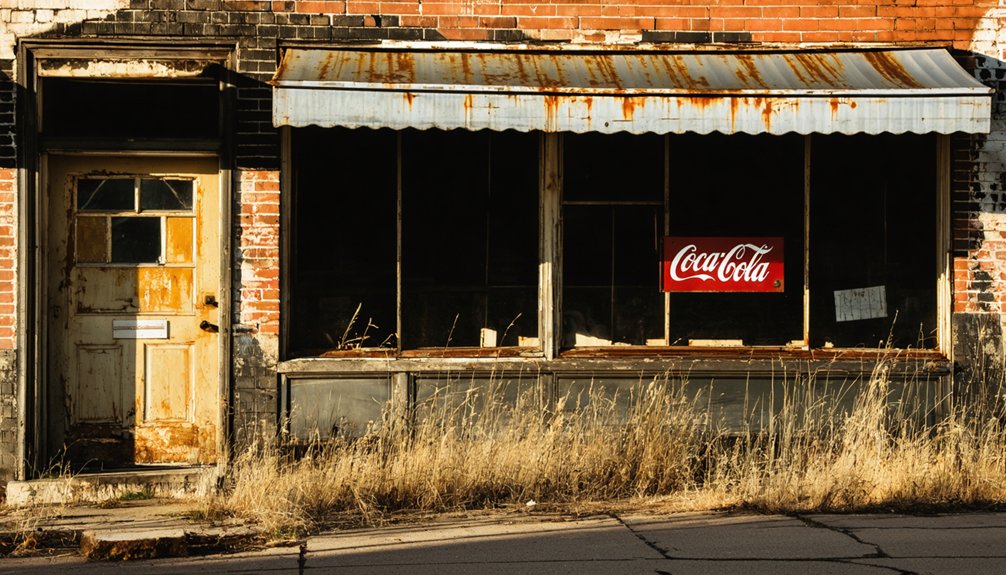You’ll find the lost prairie settlement of Caledonia three miles west of Magnolia in Putnam County, Illinois. Founded in 1828 as “Old Caledonia,” this farming community grew to about seventy-five residents by 1836, featuring two stores, a schoolhouse, and churches. Despite its promising start with the establishment of the “Ox-Bow” post office in 1835, the town’s isolation from railroads and economic limitations led to its decline. The town’s pioneering spirit lives on through its cemetery and rich historical narratives.
Key Takeaways
- Established in 1828 on Ox-Bow Prairie, Caledonia became a ghost town after failing to maintain its post office and missing railroad connections.
- The settlement peaked at seventy-five residents with two stores, a schoolhouse, and churches before declining due to economic limitations.
- Originally named “Old Caledonia,” the town’s post office operated under “Ox-Bow” due to naming conflicts with another Caledonia.
- Limited to basic agricultural activities and lacking major industries, the town struggled to compete with neighboring communities.
- Today, only the Caledonia Cemetery and historical records preserve the legacy of this former prairie settlement.
The Birth of a Prairie Settlement (1828-1836)
While many Illinois settlements grew along rivers and rail lines, Caledonia took root in 1828 on the fertile expanse of Ox-Bow Prairie, three miles west of Magnolia in Putnam County.
You’ll find this settlement’s agricultural roots deeply embedded in its founding story, as pioneers specifically chose the location for its rich prairie soil and farming potential. Taking inspiration from the ancient Roman name for Scotland, the settlers named their new community Old Caledonia.
The founding figures – Asahel Hannum, Jervas Gaylord, and Obed Graves – established the initial community with just three houses.
By 1836, they’d formally laid out the town plat, creating a modest ten-acre settlement that would eventually support about seventy-five residents.
Though lacking the advantages of river transport or railways, Caledonia’s settlers committed to building a farming community, complete with essential services like a schoolhouse by 1832 and the distinction of having the first post office in the county.
Life in Early Caledonia
As Caledonia took shape on its ten-acre plot, the settlement quickly developed into a vibrant farming community of about seventy-five residents.
You’d find two stores serving daily needs, while skilled craftsmen at the blacksmith’s shop and wheelwright’s establishment kept the town’s equipment running smoothly.
Family dynamics centered around the 1832 schoolhouse, where children gathered for their education, and community events flourished at the Methodist and Baptist churches built in the 1850s.
Life on Ox-Bow Prairie wasn’t just about working the land – you could witness neighbors supporting each other through shared religious services, school functions, and trading at local stores. Local church services often featured lengthy sermons that would last two to three hours.
The mix of farmers and tradespeople created a close-knit society where everyone played a crucial role in the town’s daily operations.
Like many settlements of the era, residents participated in a subscription-based school system where families voluntarily contributed to support local education.
The Postal Service Dilemma
Although Caledonia stood as one of Putnam County’s earliest settlements, its post office couldn’t share the town’s name due to a duplication conflict with another Caledonia in Pulaski County. Instead, locals adopted “Ox-Bow” for postal naming, referencing the distinctive prairie shape near the town.
The post office served as a crucial community connection, supporting two stores, a blacksmith shop, and a school teaching 50 children. The first postmaster was appointed on January 16, 1835, marking the official establishment of postal services in the area.
The town’s fate took a dark turn when the postmaster deliberately failed to renew the license. This decision, combined with being bypassed by the Cairo and Vincennes Railroad, severely impacted Caledonia’s viability.
As nearby Olmstead gained railway access and postal services, Caledonia’s significance diminished. Today, only the cemetery remains as evidence of this once-thriving community.
Economic Challenges and Missed Opportunities
Despite its promising location on the Ox-Bow Prairie, Caledonia struggled to achieve economic stability beyond basic agricultural pursuits. With only seventy-five residents, the town’s agricultural limitations became evident as it failed to diversify its economic base.
Despite favorable prairie positioning, Caledonia remained trapped in agricultural subsistence, unable to grow beyond its modest farming roots.
You’d have found just basic establishments – a blacksmith and wheelwright – but no major industries to drive growth.
The town’s economic stagnation was further compounded by its isolation from railways, unlike its namesake in Pulaski County. While neighboring communities like Mark and Granville prospered from coal mining, Caledonia missed these vital opportunities.
The lack of natural resources, combined with transportation constraints, prevented the town from competing effectively with nearby settlements. Environmental challenges, including mosquitoes and ague, also hindered the community’s productivity and potential for expansion.
Legacy of a Lost Town
While Caledonia no longer exists as a living community, its legacy endures through the Caledonia Cemetery and the rich historical narratives of early Illinois settlement.
You’ll find echoes of this pioneering spirit in the area’s continuing agricultural practices, which mirror those of the original settlers who transformed the Ox-Bow Prairie into productive farmland.
The town’s impact on Illinois history lives on through:
- Community events that took place in its Methodist and Baptist churches, which served as social anchors
- Educational contributions through its schoolhouse, which educated 50 children by 1873
- Agricultural innovations that helped establish Putnam County’s farming tradition
- Historical records that preserve stories of independent settlers who built a self-sufficient community from scratch
Frequently Asked Questions
Were There Any Notable Crimes or Lawlessness Incidents in Caledonia’s History?
You’ll find that, like a well-moderated Facebook group, Caledonia’s historical records don’t show any significant crime incidents or law enforcement issues during its existence as a peaceful farming community.
What Happened to the Buildings and Structures After the Town Was Abandoned?
You’ll find most buildings naturally collapsed from neglect, with no records of organized demolition. The abandoned architecture deteriorated gradually over time, leaving only a small house and cemetery for ghost town preservation.
Did Any Famous or Historically Significant People Come From Caledonia?
While you won’t find nationally famous residents, Elder James B. Chenowith gained historical significance as Sandy Creek Church’s first pastor, shaping the spiritual foundation of this freedom-loving prairie community.
What Were the Typical Land and Property Prices in Caledonia?
You’d find land valuation around $1-$5 per acre, with property trends showing modest prices under $50 per lot due to limited development and the town’s small agricultural focus.
Were There Any Natural Disasters That Affected the Town’s Development?
Contrary to what you might expect, there’s no evidence of any natural disasters affecting the town’s development. The prairie location actually protected Caledonia from common hazards like flooding and earthquakes.
References
- https://www.ghosttowns.com/states/il/caledonia.html
- https://drloihjournal.blogspot.com/2022/05/lost-towns-of-illinois-caledonia-illinois.html
- http://genealogytrails.com/ill/putnam/village_index.html
- https://en.wikipedia.org/wiki/List_of_ghost_towns_in_Illinois
- http://debdavis.org/illinois/pulaski/caledonia.htm
- http://genealogytrails.com/ill/putnam/Pioneers/t_bios.html
- http://livinghistoryofillinois.com/pdf_files/Past and present of Marshall and Putnam Counties
- https://en.wikipedia.org/wiki/Caledonia
- https://genealogytrails.com/ill/putnam/history/Speech.htm
- https://genealogytrails.com/ill/putnam/Pioneers/M_bios.html



